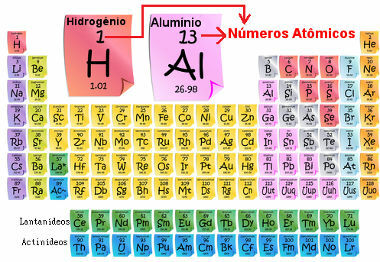The atomic number, symbolized by the letter Z, corresponds to the amount of protons existing in the nucleus of the atom of a given chemical element. For example, the atomic number of hydrogen is 1, which means it has only 1 proton in its atomic nucleus.
The atomic number usually appears next to the chemical element's subscript symbol (in the lower corner) on the left. Example: 1H.
In the ground state, the atomic number is equal to the number of electrons, since in this state the element is neutral, therefore, the amount of positive charges (protons) must equal the amount of negative charges (electrons) of the atom.
The atomic number is important because it is he who determines the main characteristics and properties of the element, as well as its behavior and location in the Periodic Table. The elements are listed in the Periodic Table in ascending order of atomic number, which usually appears above the element, as shown below. Note that the first element is hydrogen, H (Z = 1), followed by helium, He (Z = 2), then comes lithium, Li (Z = 3), and so on.

Atomic number of elements in the Periodic Table
We can even conceptualize a chemical element as being “a set of atoms that have the same atomic number”. Thus, when we talk, for example, about the chemical element oxygen, we are talking about atoms with atomic number 8. Below we have the atoms of the chemical elements from periods 1 and 2 of the Periodic Table in ascending order of atomic number:

Chemical elements from periods 1 and 2 of the Periodic Table in ascending order of atomic number
The atomic numbers were initially defined by the English physicist Henry Gwyn Jeffreys Moseley (1887-1915), and when carrying out experiments involving the bombardment of various elements chemists with X-rays, he observed that the square root of the frequency of the X-rays produced by the emission of the atomic nucleus was directly proportional to the atomic number of the element in the Table. Periodic. With this, he concluded that the atomic number was related to the properties of atoms because it represented the number of positive charges in the nucleus of each atom.
Chemical bonds do not affect the atomic number of atoms, as they only involve electrons that are in the electrosphere. However, nuclear reactions involve the atomic nucleus and hence the atomic number is included as well.
For example, when particles (mainly moderate neutrons) are bombarded onto a heavy, unstable atomic nucleus, that nucleus is broken and gives rise to two smaller atomic nuclei, that is, with a smaller number of protons and neutrons, releasing a colossal amount of energy.
Nuclear fusion, on the other hand, is the opposite process, it is when two small and light nuclei unite, originating a larger and more stable nucleus, releasing an even greater amount of energy.
Thus, whenever these nuclear reactions occur, new chemical elements originate, as the atomic numbers of the initial elements are different from the atomic numbers of the final elements. For example, see below that the fission of uranium-235 with atomic number 92 gives rise to barium (Z = 56), krypton (Z = 36) and three neutrons:

Uranium-235 nuclear fission reaction
By Jennifer Fogaça
Graduated in Chemistry
Source: Brazil School - https://brasilescola.uol.com.br/o-que-e/quimica/o-que-e-numero-atomico.htm
